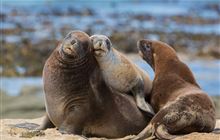Record sea lion pup numbers in Dunedin
Introduction
Pakake/sea lions in Dunedin have had the best breeding season on record, with more than 30 pups born.Date: 28 March 2024
DOC Coastal Otago Biodiversity Ranger Jim Fyfe says 29 pups have been tagged to date.
“We’re thrilled with this result, which is a big jump from the 21 pups tagged last season.”
Jim Fyfe says it’s fantastic to think how far the species has come since the first sea lion to breed on the mainland, known as Mum, had her first pup here in 1993.
“It feels like Dunedin’s sea lion population has turned a corner, with a widespread presence across local beaches, and these numbers are a great reflection of the increased presence we’re seeing.”
“Interestingly, we never found the birthplace for at least a dozen pups; for all the ones born in very public places, there were many others that managed to remain hidden away. This is amazing, given how populated our coastal areas are, and there was some effort made to search more isolated areas.”
Jim Fyfe says the pups are now getting more active and venturing out from their birthing sites. Although they are “creching” (or congregating so they can interact to learn through play) they are still mobile and may appear in unexpected places in coastal areas. Pups are reliant on their mothers for about 11 months.
“People are asked to keep an eye out for sea lions, especially when driving on coastal roads – please slow down, it could save a sea lion’s life.”
“If you do see one – whether in the car or on foot – make sure to give it plenty of space.”
If you see one on the road, please report it to DOC by calling the DOC emergency hotline
- 0800 DOC HOT (0800 362 468).
Jim Fyfe says another two pups are known to have died of natural causes – one was stillborn and the other was accidentally crushed by a large male sea lion.
Tūmai Cassidy from Te Rūnanga o Ōtākou says both whakahao (male sea lions) and kake (female sea lions) are highly valued taoka for the people of Ōtākou and Ngāi Tahu.
“A source of mahika kai, oil and clothing, the sea lion has always been a part of our traditions, whakapapa and culture.”
“Ōtākou hapū members have been involved in the monitoring and management of the growing population since the species first made its return to our takiwā in 1993. Our whānau continue to contribute to the ongoing conservation of our taoka today alongside our treaty partners, including this year’s pup tagging efforts.”
“The fact that our coastlines have enough life to support the growth of their population is a good sign for us. Sea lions are a key part of our ocean and coastal ecosystems and play a vital role in restoring the abundance that formerly existed in our rohe. We hope their population continues to increase for many generations to come.”
New Zealand Sea Lion Trust’s Mike Neill says the trust is thrilled numbers are increasing around the Otago coastline.
“We remind members of the public to continue to respect these wonderful animals by maintaining a 20m distance when enjoying their company.”
Background information
The New Zealand sea lion is one of the rarest sea lion species in the world, with a threat status of Nationally Vulnerable.
They have a total population of about 12,000 but the vast majority live in the Subantarctic Islands, with only a small number found in Rakiura/Stewart Island, Southland and Dunedin. There are thought to be 34 breeding females in Dunedin, with about 160-200 sea lions in the region in total (the number fluctuates as the males move around).
Contact
For media enquiries contact:
Email: media@doc.govt.nz


